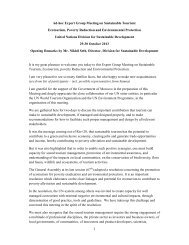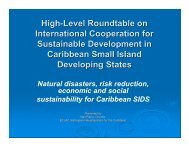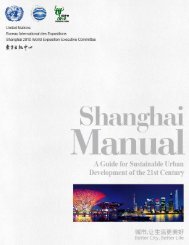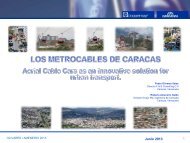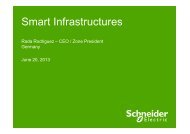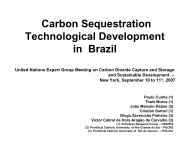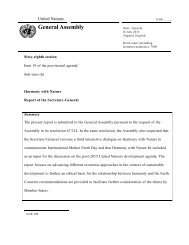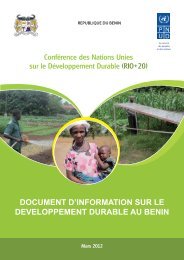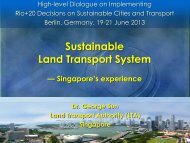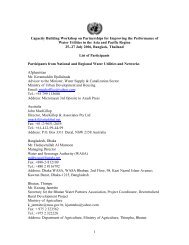oilers and new electric appliances exist and are also important in many countries.Many countries have home energy standards <strong>for</strong> home appliances.(e) Linkages to Other <strong>Indicators</strong>: This indicator is part of a set <strong>for</strong> energy intensitiesin different sectors (manufacturing, agriculture, transport and service/commercial),with the indicator <strong>for</strong> energy use per unit of gross domestic product (GDP) as anaggregate energy intensity indicator. These indicators are also linked to indicators oftotal energy and electricity use, greenhouse gas emissions and air pollutant emissions.METHODOLOGICAL DESCRIPTION(a) Underlying Definitions and Concepts: Household energy use encompassesenergy used in residential buildings, including urban and rural free-standing houses,apartment dwellings and most collective dwellings such as dormitories and barracks.These energy uses typically include cooking, water heating, space heating andcooling, lighting, major appliances <strong>for</strong> refrigeration, washing and drying, televisionand communications, computers, conveniences like food processing machines,vacuum cleaners, etc., as well as a myriad of small appliances. Household energy useshould exclude energy <strong>for</strong> farm processes, small businesses or small industry. Thehousehold sector must be separated from the service/commercial sector. The energyfuel options should include not only commercial energy, but also non-commercialenergy sources such as fuelwood and other biomass fuels.Changes in intensities are affected by factors other than energy efficiency; there<strong>for</strong>e,analysing intensity trends provides important insights into how energy efficiency andother factors affect energy use. Annex 3 includes a decomposition method <strong>for</strong> energyintensities.(b) Measuring Methods:<strong>Energy</strong> Use: Commercial energy <strong>for</strong> households is usually recorded in the energystatistics of countries based on data provided by electric, gas or heat utilitiesaccording to customer definitions that correspond to ‘households’. Data on purchasesof liquefied petroleum gas (LPG), other oil products, coal or similar fuels and woodare not always recorded correctly since suppliers may not know where or how thesefuels are being used.More in<strong>for</strong>mation on different end uses in the household sector can be obtainedthrough household surveys. The most direct surveys collect detailed in<strong>for</strong>mation onboth fuels consumed and energy-using equipment owned or used. The most accuratesurveys also collect data (with permission from households) from energy suppliers <strong>for</strong>quantities consumed, or they use fuel-use diaries <strong>for</strong> households to record what isconsumed. The surveys measure usage in a variety of appliances and in heatingequipment using miniature data loggers. Less-detailed surveys estimate the use ofeach fuel <strong>for</strong> each major purpose through regression analysis over a large number ofhouseholds.Unit: toe <strong>for</strong> final energy and kWh <strong>for</strong> electricity.Activity: At the aggregate level, residential energy use is calculated on a per capita orper household basis, or if data are available, per unit of floor area. In general, energyuse depends on both the physical size and characteristics of the dwelling, on the64
number of people and on ownership levels of electric appliances. As the number ofpeople in a household declines, energy use per household declines, while the energyuse per capita increases. <strong>Energy</strong> use <strong>for</strong> water heating and cooking, and <strong>for</strong> manyappliances tends to vary with the household size and the number of people perhousehold.For developing countries with large rural sectors or large numbers of homes withoutaccess to electricity, the share of homes connected to the electricity grid is animportant factor in total household energy use. The shares of homes using differentkinds of combustible renewables and waste (CRW) are also important.(c) Limitations of the Indicator: When energy use by end use is not known, energyuse per household can be used as an energy-intensity indicator, but it does notmeasure energy efficiency developments very well. Some important conclusions canbe drawn, however, if the average winter temperature, ownership of energy-usingappliances and dwelling size are known. In a country with cold winters and a highpenetration of central heating systems, a low total use of energy <strong>for</strong> all purposes,relative to total home (floor) area and the severity of winter climate, probably impliesefficient heating practices. Conversely, high energy use relative to floor area in acountry with mild winters might imply inefficiencies. However, since energy-usehabits vary so much, both among countries and among end uses, few conclusionsabout efficiency can be drawn from the indicator on residential energy use perhousehold.The measurement and interpretation of energy intensities are complicated bydifferences among products within a category, such as size (e.g. refrigerator capacity),features (freezer compartments in refrigerators) and utilization (hours per year a stoveis used).(d) Alternative Definitions/<strong>Indicators</strong>: None.(e) Measurement of Efficiency: To describe energy efficiency developments,intensities should be expressed as energy use per unit of disaggregated energy service.The inverse of these intensities would then reflect energy efficiency — <strong>for</strong> example,litres of refrigerated volume at a given temperature divided by electricity use <strong>for</strong>refrigeration, lumens of light per watt of power consumed, or computer tera-flops persecond divided by power consumption <strong>for</strong> the computer, etc. In practice, these kindsof disaggregated data are not available. For some household equipment, specificenergy requirements can be calculated from survey data on equipment efficiency andusage time per year <strong>for</strong> the equipment.Activity (Services Provided): Ideally, output units would be in energy servicesdelivered, such as lumens of lighting, number of meals cooked, area and time heated,litres of hot water provided, litres refrigerated, kilograms of clothes washed, etc. Inpractice such data are rarely available, even <strong>for</strong> individually metered homes. If dataseparating residential energy use by main end use are available, floor area should beused as the activity measure <strong>for</strong> space heating, air conditioning and lighting; numberof persons per household, <strong>for</strong> water heating and cooking; and ownership levelsmeasured as number of devices per household, <strong>for</strong> important electric householdappliances.65
- Page 2 and 3:
Photos on the cover:D. Kinley, IAEA
- Page 4 and 5:
COPYRIGHT NOTICEAll IAEA scientific
- Page 6 and 7:
IAEA Library Cataloguing in Publica
- Page 8 and 9:
agency report. Their work also bene
- Page 10 and 11:
Environmental Dimension ...........
- Page 12 and 13:
progress towards sustainability. Fi
- Page 15 and 16:
2. BACKGROUNDSince the publication
- Page 17 and 18:
presented in this report. A short d
- Page 19 and 20:
In the 2004 edition of the World En
- Page 21 and 22:
3. ENERGY INDICATORS FOR SUSTAINABL
- Page 23 and 24: EconomicTheme Sub-theme Energy Indi
- Page 25 and 26: EnvironmentalTheme Sub-theme Energy
- Page 27 and 28: income. Inadequate equipment and ve
- Page 29 and 30: the cost of delivery are necessary
- Page 31 and 32: Paradoxically, the economic and env
- Page 33: • Shares of sectors in GDP value
- Page 36 and 37: might be collected by another, or t
- Page 38 and 39: 4.3. Priorities and Approaches for
- Page 40 and 41: (b) Relevance to Sustainable Develo
- Page 42 and 43: • IEA, various editions. Energy S
- Page 44 and 45: (b) National and International Data
- Page 46 and 47: energy availability and affordabili
- Page 48 and 49: SOC4: Accident fatalities per energ
- Page 50 and 51: Proceedings of a Technical Committe
- Page 52 and 53: REFERENCES• IEA, various editions
- Page 54 and 55: geography and the structure of the
- Page 56 and 57: (b) Relevance to Sustainable Develo
- Page 58 and 59: • UNSD, various editions. Energy
- Page 60 and 61: • USGS, various editions. World P
- Page 62 and 63: ECO6: Industrial energy intensities
- Page 64 and 65: Units: toe for final energy and kWh
- Page 66 and 67: • Unander, F., Karbuz, S., Schipp
- Page 68 and 69: other inputs, etc). These factors a
- Page 70 and 71: (d) International Targets/Recommend
- Page 72 and 73: ASSESSMENT OF DATA(a) Data Needed t
- Page 76 and 77: Disaggregated Intensities: Using th
- Page 78 and 79: educe the environmental impacts of
- Page 80 and 81: (d) Alternative Definitions/Indicat
- Page 82 and 83: (c) International Conventions and A
- Page 84 and 85: ECO12: Non-carbon energy share in e
- Page 86 and 87: • IEA, 1990-2001. Energy Statisti
- Page 88 and 89: ASSESSMENT OF DATA(a) Data Needed t
- Page 90 and 91: connection to the electricity or ga
- Page 92 and 93: Further problems include differing
- Page 94 and 95: Re-exports of oil imported for proc
- Page 96: (c) International Conventions and A
- Page 99 and 100: does not show how much the climate
- Page 101 and 102: • World Bank, various editions. W
- Page 103 and 104: a time frame as possible so that lo
- Page 105 and 106: ENV3: Air pollutant emissions from
- Page 107 and 108: METHODOLOGICAL DESCRIPTION(a) Under
- Page 109 and 110: In the first instance, countries sh
- Page 111 and 112: ENV4-1: Contaminant discharges in l
- Page 113 and 114: downstream. Contamination of fresh
- Page 115 and 116: ENV4-2: Oil discharges into coastal
- Page 117 and 118: (b) Measuring Methods: Estimates of
- Page 119 and 120: Acidification is a priority atmosph
- Page 121 and 122: national authorities under the CLRT
- Page 123 and 124: United Nations Convention to Combat
- Page 125 and 126:
• Harcharik, D.A., 1995. Forest R
- Page 127 and 128:
indicator, radioactive waste and (s
- Page 129 and 130:
(b) Relevance to Sustainable Develo
- Page 131 and 132:
more easily available, as in many c
- Page 133 and 134:
Agency (IAEA). In 1995, the IAEA pu
- Page 135 and 136:
• Low- and intermediate-level rad
- Page 137 and 138:
ENV10: Ratio of solid radioactive w
- Page 139 and 140:
under development in some countries
- Page 141:
• IAEA, 1997. Joint Convention on
- Page 144 and 145:
EEA, 2002. Review of Selected Waste
- Page 146 and 147:
FAO, 1988. Energy Conservation in A
- Page 148 and 149:
IEA, 2000. The IEA Energy Indicator
- Page 150 and 151:
OECD, 2001. Key Environmental Indic
- Page 152 and 153:
UNEP/WHO, 1992. Urban Air Pollution
- Page 155 and 156:
RELATED INTERNET SITES• CONCAWE (
- Page 157:
• WEC (World Energy Council):http
- Page 160 and 161:
Particulates: Terms commonly associ
- Page 162 and 163:
TOCTPESTSPVOCtotal organic carbonto
- Page 165 and 166:
ANNEX 3: A DECOMPOSITION METHOD FOR
- Page 167 and 168:
Total Final ConsumptionHouseholds T
- Page 169 and 170:
Thus through calculating the relati
- Page 171:
Annex 4: Units and Conversion Facto



